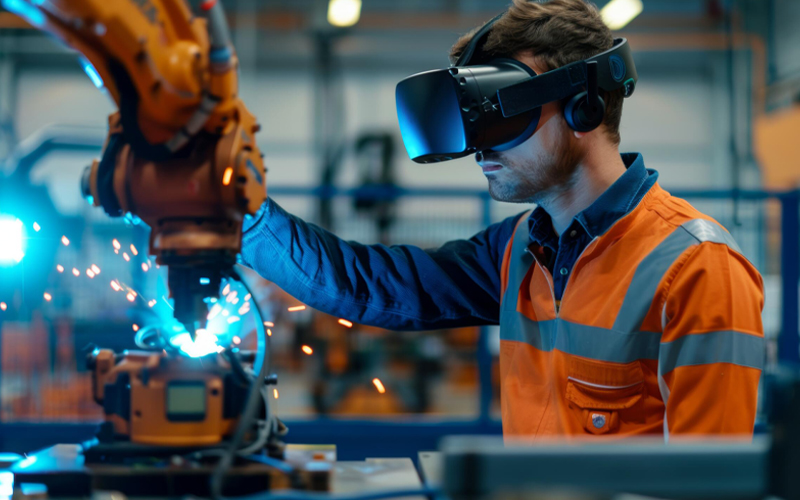In today's rapidly changing industrial landscape, the plant floor is a vital area where the challenges and opportunities of digital transformation come together, moulding the future of manufacturing. The plant floor, once dominated by manual processes, is now becoming a realm of interconnected devices, data analytics and AI. However, digital transformation is a frequently used phrase that has evolved into an all-encompassing term with varying interpretations among people. Lack of a clear vision and leadership can pose a challenge in bringing about a successful digital transformation in the traditional manufacturing industry.
According to a McKinsey report, the goal of digital transformation is to continuously deploy tech at scale and build a competitive advantage. This helps in improving customer experience and lowering costs. The journey towards a fully digitised organisation comes with challenges that need careful consideration and strategic planning.
- Organisational Hurdles:
- Financial Challenges:
- Technological Dilemmas:
Resisting Change:
Adoption of new technologies can take a backseat with resistance to change. This might be stemming from both employees and the management. Transitioning to a digitally-driven plant floor necessitates a cultural shift within the organisation. Employees accustomed to traditional processes may resist changes that disrupt their routine.
Unclear Strategy:
Lack of a well-defined digital transformation strategy can lead to inefficient technology implementation.
Silos and Communication Barriers:
Departmental isolation and poor communication can obstruct the smooth integration of digital solutions across the plant floor.
Change Management:
Investment in change management strategies can help in shaping a culture that embraces change. The involvement of stakeholders and clear articulation of the benefits of digitalisation can bring about an effective change to both the business and its workforce.
Workforce Upskilling:
Shifting to a digital-driven environment demands a skilled workforce capable of operating, maintaining, and troubleshooting complex digital systems. Bridging the skills gap is a formidable challenge. Employees need training to understand new technologies, data analytics, and automation processes. Effective change management strategies are crucial to gain employee buy-in and create a culture of continuous learning.
Initial Investment: The cost of acquiring and implementing digital technologies can be substantial, particularly for smaller organisations. While the potential benefits of digital transformation are impressive, the upfront costs can be substantial. Investing in new technologies, software, hardware, and workforce training requires a well-defined budget and a clear understanding of the long-term return on investment. Balancing these costs against anticipated gains can be a complex financial decision.
ROI Ambiguity:
Measuring the return on investment (ROI) for digital transformation can be challenging, making it difficult to justify the initial expenses.
Legacy Systems:
One of the most significant hurdles in digital transformation is dealing with legacy systems that have been in place for years. Many manufacturing facilities rely on a patchwork of old and new technologies, making integration a complex task. Retrofitting these legacy systems to communicate seamlessly with modern digital solutions requires a delicate balance between maintaining production continuity and implementing new technologies.
Data Security and Privacy:
With the increase in data generation and sharing, safeguarding against data breaches and cyberattacks becomes a paramount concern. As the plant floor becomes more interconnected, the sheer volume of data generated and exchanged increases exponentially. This abundance of data presents significant security and privacy challenges. Protecting sensitive information from cyber threats and ensuring compliance with data regulations become paramount. Developing robust cybersecurity measures that safeguard both production processes and proprietary data is essential to prevent disruptions and breaches.
Scalability and Future-Proofing:
Choosing adaptable technologies that can evolve with changing industry needs is essential to avoid early obsolescence. Digital transformation is not a one-size-fits-all solution. Enterprises often grapple with the challenge of how to implement technologies that can scale with the business's growth and adapt to changing market demands. The challenge lies in selecting the right technologies that offer both scalability and flexibility, allowing manufacturers to evolve without undergoing a complete overhaul each time new requirements emerge.
Data Overload and Analytics:
While data is the cornerstone of digital transformation, managing the vast amounts of data generated can quickly become overwhelming. Extracting actionable insights from this data requires advanced analytical tools and skilled data analysts. Without proper data management strategies in place, manufacturers risk drowning in data without reaping its potential benefits.
The challenges of digital transformation on the plant floor are real, but they are not insurmountable. Industry 4.0 represents a paradigm shift in manufacturing and various other industries. It offers the potential for increased efficiency, cost savings, innovation, and competitiveness. However, it also poses challenges, including the need for substantial investments in technology, workforce upskilling, and addressing cybersecurity concerns. Despite these challenges, many industries are embracing Industry 4.0 to stay competitive in the rapidly evolving global marketplace.
*For organizations on the digital transformation journey, agility is key in responding to a rapidly changing technology and business landscape. Now more than ever, it is crucial to deliver and exceed on organizational expectations with a robust digital mindset backed by innovation. Enabling businesses to sense, learn, respond, and evolve like a living organism, will be imperative for business excellence going forward. A comprehensive, yet modular suite of services is doing exactly that. Equipping organizations with intuitive decision-making automatically at scale, actionable insights based on real-time solutions, anytime/anywhere experience, and in-depth data visibility across functions leading to hyper-productivity, Live Enterprise is building connected organizations that are innovating collaboratively for the future.







